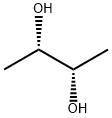A1213412
2-Butyne-1,4-diol , >99.0%(GC) , 110-65-6
Synonym(s):
1,4-Dimethoxyacetylene;2-Butyne-1,4-diol
CAS NO.:110-65-6
Empirical Formula: C4H6O2
Molecular Weight: 86.09
MDL number: MFCD00002915
EINECS: 203-788-6
Update time: 2022-07-08
PRODUCT Properties
| Melting point: | 54 °C |
| Boiling point: | 238 °C(lit.) |
| Density | 1.2 |
| bulk density | 500kg/m3 |
| vapor pressure | <0.1 mm Hg ( 55 °C) |
| refractive index | 1.4804 |
| Flash point: | 306 °F |
| storage temp. | Store below +30°C. |
| solubility | 3740g/l |
| form | Crystalline Platelets or Flakes |
| pka | 12.72±0.10(Predicted) |
| color | slightly brown |
| PH | 4-7.5 (100g/l, H2O, 23℃) |
| Water Solubility | 3740 g/L (20 ºC) |
| BRN | 1071237 |
| Exposure limits | ACGIH: TWA 0.1 ppm; STEL 0.3 ppm OSHA: TWA 0.75 ppm; STEL 2 ppm NIOSH: IDLH 20 ppm; TWA 0.016 ppm; Ceiling 0.1 ppm |
| Stability: | Stable. Highly flammable solid. Incompatible with strong oxidizing agents, acid chlorides, acid anhydrides, strong acids, strong bases. |
| LogP | -0.73 at 25℃ |
| CAS DataBase Reference | 110-65-6(CAS DataBase Reference) |
| NIST Chemistry Reference | 2-Butyne-1,4-diol(110-65-6) |
| EPA Substance Registry System | 2-Butyne-1,4-diol (110-65-6) |
Description and Uses
2-Butyne-1,4-diol is used as a precursor to prepare 1,4-butanediol, 2-butene-1,4-diol and mucochloric acid. It is also used in textile additives, corrosion inhibitors, plasticizers, synthetic resins and polyurethanes. It is an important raw material of vitamin B6. Further, it is used for brightening, preserving and inhibiting nickel plating. In addition, it is used in biological studies for nematocidal activity.
Safety
| Symbol(GHS) |    GHS05,GHS06,GHS08 |
| Signal word | Danger |
| Hazard statements | H301+H311+H331-H314-H317-H373 |
| Precautionary statements | P260-P280-P303+P361+P353-P304+P340+P310-P305+P351+P338-P314 |
| Hazard Codes | T,C |
| Risk Statements | 21-23/25-34-43-48/22 |
| Safety Statements | 25-26-36/37/39-45-46 |
| RIDADR | UN 2716 6.1/PG 3 |
| WGK Germany | 2 |
| RTECS | ES0525000 |
| F | 23-10 |
| Autoignition Temperature | 410 °C |
| TSCA | Yes |
| HazardClass | 6.1 |
| PackingGroup | III |
| HS Code | 29053980 |
| Hazardous Substances Data | 110-65-6(Hazardous Substances Data) |
| Toxicity | LD50 orally in Rabbit: 100 mg/kg |




